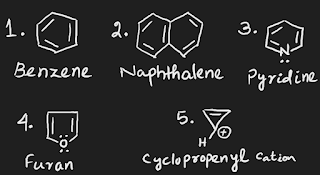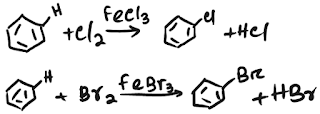Notes on GE Chemistry - II (Generic Elective Chemistry - II)
Aromatic Hydrocarbons:
Compounds having chemistry similar to benzene are traditionally known as aromatic compounds. Benzene shows some unexpected chemical behaviour and a remarkable stability despite the presence of high degree of unsaturation. This special characteristic which imparts stability to the aromatic compounds is called the aromaticity.
Aromaticity is a property of typical cyclic planar molecular structures which are generally more stable compared to similar geometric or connective arrangements with the same set of atoms due to pi bonds in resonanance (or delocalisation of electrons).
Conditions of aromaticity: The compounds or species are considered to be aromatic if they fulfill the following conditions:
1. The cyclic compounds must have conjugated double bonds.
2. Each ring atom should have an unhybridised p orbital to result in sp2 hybidisation. These unhybridised p orbitals must overlap to form a continuous ring of parallel orbitals.
3. The structure must be planar or nearly planar to faciliatate efficient overlaping of orbitals.
4. Most of the aromatic compounds obey Huckel's rule which states that aromatic compounds should have (4n+2) number of pi electrons, n being an integer.
5. The delocalisation of the pi elctrons over the entire ring must decrease the electronic energy compared to equivalent open chain structure (linear chain of sp2 hybridised atoms carrying the same number of pi electrons).
Examples of aromatic species:
2. Naphthalene: Compound is planar having conjugated double bonds. 4n+2 = 10, hence n = 2. Its an aromatic compound.
3. Pyridine: The lone pair over nitrogen atom is excluded as it is exocyclic and is not a part of conjugation. The compound is planar and conjugated double bond present. 4n+2 = 6, hence n = 1. Its an aromatic compound.
4. Furan: One of the lone pair takes part in conjugation including which number of pi electrons becomes 6. The compound is planar. 4n+2 = 6, hence n = 1. Its an aromatic compound.
4. Furan: One of the lone pair takes part in conjugation including which number of pi electrons becomes 6. The compound is planar. 4n+2 = 6, hence n = 1. Its an aromatic compound.
5. Cyclopropenyl cation: The cation is planar. 4n+2 = 2, hence n = 0. Its an aromatic species.
6. Cyclopentadiene: Compound is planar. But 4n+2 = 4, hence n = 1/2. Its not an aromatic species.
6a. Cyclopentadienyl anion: It is planar. The negative charge takes part in delocalisation or conjugation. 4n+2 = 6, hence n = 1. It's an aromatic species.
7. Cycloheptatriene: The compound is not planar due to the methylene (CH2) group in another plane. The 6 pi electrons are not delocalised over the entire ring. Hence it is not an aromatic compound.
7a. Cycloheptatrienyl (tropylium) cation: The whole 6 pi electrons this time are delocalised over entire ring. 4n+2 = 6, hence n = 1. It's an aromatic species.
Antiaromatic and Nonaromatic compounds:
We discussed above that in aromatic compounds the delocalisation of the pi elctrons over the ring decrease the electronic energy compared to open chain counterpart. On the other hand, in antiaromatic compounds the delocalisation of pi electrons over the entire ring increases the electronic energy compared to equivalent open chain structure, even though they satisfy most of the conditions of aromaticity (such as planarity and conjugation of double bonds). These antiaromatic componds contain 4n number of pi electrons.
If the cyclic compound and its open chain counterpart have the same pi electron energy, then the cyclic compound is called the non aromatic compound. Non aromatic compounds in general also contain 4n number of pi electrons and are non planar.
Aromatic hydrocarbons: Aromatic organic molecules which contain only carbon and hydrogen atoms are called aromatic hydrocarbons. In this concern, the very common compounds which we consider are benzene, toluene, ethyl benzene and xylenes. These are well-known environmental pollutants.
Methods of Preparation of Benzene:
1. By cyclic polymerisation of acetylene (Berthelot synthesis): Three moles of acetylene undergo cyclic polymerisation in presence of CaC2 (as catalyst) when pased inside red hot tube to form benzene.
2. Cyclization of n -alkanes: n-alkanes of six or more carbon atoms undergo cyclization in presence of chromium oxide and aluminium oxide at high temperature and pressure to form benzene. n-hexane needs 500 - 550 degree centigrade and high pressure to undergo cyclisation in presence of chromium and aluminium oxiide as catalyst.
3. By decarboxylation of sodium salt of carboxylic acid: Heating sodium benzoate with sodalime (NaOH+CaO) results benzene.
5. From chlorobenzene: Chloro benzene on reduction with Raney nickel (Ni/Al alloy + Conc. NaOH) forms benzene.
6. By hydrolysis of benzene sulphonic acid: Hydrolysis of benzene sulphonic acid either by super heated steam or by heating with diluted HCl gives benzene.
7. From benzene diazonium chloride: BDC on treatment with hypophosphorous acid or with ethyl alcohol gives benzene.
8. From Grignard's reagent: Hydrolysis of Grignard's reagent results benzene.
C6H5MgX + HOH =========> C6H6 + Mg(OH)X
Chemical Properties:
Electrophilic substitution reaction (SE reaction):
Since no particular bond is double bond in aromatic compounds due to resonance, we can not ecxpect an electrophilic addition reaction unlike alkenes.
Aromatic compounds show electrophilic substitution reaction as they are the rich source of electrons.
In the first step, the electrophile is generated by the presence of a lewis acid like FeCl3 or anhydrous AlCl3 or by a protonic acid.
In the next step pi electron cloud of aromatic ring attacks the electon defficient centre (the electrophile) to form a sigma complex.
And in the last step, another electrophile from the ring is released in exchange.
In other words an electrophille is substituted for another elctrophile. This mechanism of the reaction is called electrophilic substitution reaction.
We will discuss halogenation, nitration, sulphonation, F.C alkylation and acylation as the examples of electrophilic substitution reaction one by one.
Halogenation:
Benzene when reacts with chlorine or bromine in presence of a lewis acid like FeCl3 or anhydrous AlCl3 an in absence of sunlight chlorobenzene and bromobenzene are formed respectively.
In a similar way, bromination can be explained.
Nitration:
Benzene when reacts with mixture of conc. HNO3 and Conc. H2SO4 (called nitrating mixture) at 60 degree centigrade undergoes nitration and forms nitrobenzene.
Sulphonation:
Benzene when reacts with conc. sulphuric acid at 60 degree centigrade undergoes sulphonation and forms benzene sulphonic acid.
You are suggested to check this page regularly to get next updates. Thank you so much for visiting our website.


.png)
.png)


.png)

.png)
.png)
.png)
.png)




Thank you it is very helpful for me
ReplyDeleteWonderful explanation 😀😀
ReplyDeleteLove 💖 from Maharashtra
Thank u you so much sir
ReplyDelete